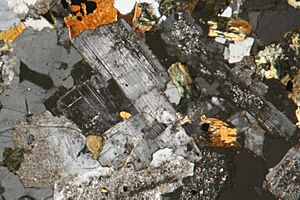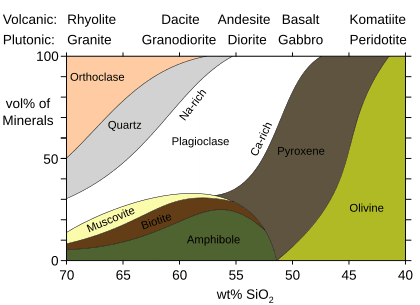Granodiorite facts for kids

Granodiorite (pronounced GRAN-oh-DY-rite) is a type of rock that forms deep inside the Earth. It looks a lot like granite, but it has more of a mineral called plagioclase feldspar than another mineral called orthoclase feldspar. It's known for its coarse-grained texture, meaning you can easily see the different mineral crystals with your eyes.
Sometimes, people informally use the name banatite for different rocks that are somewhere between granite and diorite, and this often includes granodiorite. The word granodiorite was first used in 1893 by a scientist named George F. Becker to describe rocks he found in the Sierra Nevada mountains in the United States.
Contents
What is Granodiorite Made Of?
Granodiorite is a rock that forms from cooled magma deep underground. It's considered a "felsic" to "intermediate" rock, which means it has a good amount of silica (a common mineral found in rocks).
How Do We Classify Granodiorite?
To understand what makes granodiorite unique, geologists use something called a QAPF diagram. This diagram helps classify rocks based on the amounts of four main minerals:
- Q for quartz
- A for alkali feldspar (like orthoclase)
- P for plagioclase feldspar
- F for feldspathoids (which are not usually in granodiorite)
For a rock to be called granodiorite, it must have more than 20% quartz by volume. Also, between 65% and 90% of its total feldspar content must be plagioclase. If it had even more plagioclase, it would be classified as a different rock called tonalite.
What Minerals Are in Granodiorite?
Granodiorite contains several different minerals that give it its unique look and properties:
- Plagioclase Feldspar: This is the most common feldspar in granodiorite and is rich in sodium (Na) and calcium (Ca). It often looks white or gray.
- Potassium Feldspar: Also known as orthoclase, this mineral is present but in smaller amounts than plagioclase. It can be pinkish or white.
- Quartz: This mineral is usually clear or smoky gray and looks like glassy grains.
- Muscovite Mica: This is a lighter-colored mica that can appear as shiny, flaky crystals.
- Biotite Mica: This is a darker mica, often black or dark brown, and is more common in granodiorite than in granite.
- Amphiboles: Often found as hornblende, these minerals are usually dark green or black and can look like needle-shaped crystals.
The presence of more biotite and amphiboles makes granodiorite look darker or more "two-toned" compared to the generally lighter granite. You might also find tiny amounts of other minerals like magnetite (an oxide) or some sulfide minerals.
Where Does Granodiorite Form?
Granodiorite is a plutonic igneous rock. This means it forms when hot, molten rock (magma) cools down and solidifies deep beneath the Earth's surface. This cooling happens very slowly, which allows the mineral crystals to grow large enough to be seen easily, giving the rock its "coarse-grained" texture.
These large bodies of cooled magma are called batholiths or stocks. Granodiorite usually only appears on the Earth's surface after millions of years of uplift (when land is pushed up) and erosion (when wind, water, and ice wear away the land above it). Interestingly, the average composition of the upper part of the Earth's continental crust is very similar to granodiorite.
How Did Granodiorite Get Its Name?
The name "granodiorite" is a combination of two other rock names: granite and diorite. This is because granodiorite has characteristics that are in between these two rocks.
- The "gran-" part comes from the Latin word grānum, which means "grain." This refers to the grainy texture of the rock, where you can see the individual mineral crystals.
- The "diorite" part comes from the Greek word diorizein, meaning "to distinguish" or "to separate." This refers to the way the dark and light minerals in diorite (and granodiorite) often stand out from each other.
Banatite: A Regional Name
"Banatite" is a term sometimes used informally for a group of rocks, often including granodiorite, that formed during the Late Cretaceous period. These rocks are found in a region called the Banat, which is in parts of modern-day Hungary and Serbia. The term is also used in other places, like Australia, to describe similar rocks.
Where Can You Find Granodiorite?
Granodiorite is found in many places around the world, especially in areas where there have been ancient mountain-building events.
Granodiorite in the United States
- The famous Plymouth Rock in Massachusetts, where the Pilgrims are said to have landed, is actually a large glacial erratic boulder made of granodiorite. A glacial erratic is a rock that was carried a long distance by a glacier and then left behind when the glacier melted.
- The Sierra Nevada mountains in California contain huge sections of granodiorite, forming much of their impressive peaks.
Granodiorite in Ancient Egypt
- Granodiorite was quarried (mined) in ancient Egypt at a place called Mons Claudianus, located in the eastern desert. This happened from the 1st century AD to the mid-3rd century AD.
- Much of this quarried stone was sent all the way to Rome to be used in famous buildings like the Pantheon and Hadrian's Villa.
- Perhaps the most famous artifact made of granodiorite is the Rosetta Stone. This ancient stone slab was key to understanding Egyptian hieroglyphs.
Granodiorite in Ireland
- In the Newry area of County Armagh in Northern Ireland, granodiorite is quarried and is commonly known as 'Newry granite'.
What is Granodiorite Used For?
Granodiorite is a strong and durable rock, making it useful for many purposes:
- Road Building: Most often, granodiorite is crushed and used as aggregate for building roads.
- Construction Material: It's used as a general construction material for buildings.
- Building Facades and Paving: Its attractive appearance and durability make it suitable for the outside walls of buildings and for paving stones.
- Ornamental Stone: It's also used as a decorative stone in various architectural and artistic projects.
- Historical Structures: As mentioned, the Rosetta Stone is made of granodiorite. Also, the massive columns at the front of the Pantheon in Rome are each made from a single piece of granodiorite, standing 12 meters (about 39 feet) tall and 1.5 meters (about 5 feet) wide!
See Also





